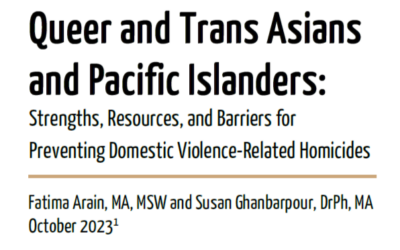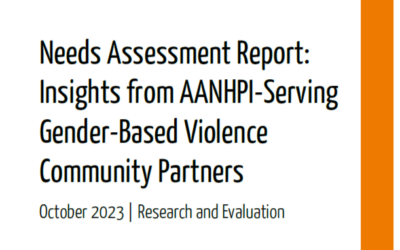Statistics on Violence Against API Women
Domestic Violence
- 21 – 55% of Asian women in the U.S. report experiencing intimate physical and/or sexual violence during their lifetime, based on a compilation of disagregated samples of Asian ethnicities in local communities.
Facts & Stats Report (2015) - 18% of Asian or Pacific Islander women reported experiencing rape, physical violence, and/or stalking by an intimate partner in their lifetime in a national survey, as compared to 48% of American Indians or Alaska Native women, 45% of Black women, 34% of Hispanic women, and 37% of White women.
CDC: 2010-2012 National Intimate Partner and Sexual Violence Survey (2017)
Graphic from AAPIdata.com. Data from Leung C & Cheung C. 2008. A prevalence study on partner abuse in six Asian American ethnic groups in the USA. International Social Work. 51(5): 635 – 649.
Domestic Violence-Related Homicide
-
- In a six-year period, 160 cases in Asian families resulted in 226 fatalities, of which 72% were adult homicide victims, 10% were child homicide victims, and 18% were suicide deaths.
- 68% of victims were intimate partners (current, estranged, or ex-partners), of which 111 were women and 14 were men.
- 83% of homicide perpetrators were men, 14% were women, 3% unknown.
- Children were the second largest group of victims, and the parents of wives and girlfriends were the third largest group.
Shattered Lives (2010)
Graphic from AAPIdata.com. Data from Yoshioka MR, DiNoia J, & Ullah K. 2001. Attitudes toward marital violence: An examination of four Asian communities. Violence Against Women. 7(8): 900 – 926.
Sexual Violence
- Of API women, 23% experienced some form of contact sexual violence, 10% experienced completed or attempted rape, and 21% had non-contact unwanted sexual experiences during their lifetime.
CDC: 2010-2012 NISVS Summary Report (2017) - 56% of Filipinas and 64% of Indian and Pakistani women had experienced sexual violence by an intimate in a study of 143 domestic violence survivors.
Intimate Partner Violence and Help-Seeking (2011)
Stalking
- 8% of API women experienced stalking in their lifetime
CDC: 2010-2012 NISVS Summary Report (2017) - 68% of Filipinas and 50% of Indian and Pakistani abused women reported being stalked by an intimate partner
Intimate Partner Violence and Help-Seeking (2011)
Children’s Exposure to Family Violence
- 70% of Cambodians, 61% of Chinese, 80% of Koreans, 79% of South Asians, and 72% of Vietnamese men and women reported being hit regularly as children.
ATASK: Asian Family Violence Report (2000) - 28% of Cambodians, 18% of Chinese, 30% of Koreans, 8% of South Asians, and 27% of Vietnamese witnessed their fathers regularly hit their mothers.
ATASK: Asian Family Violence Report (2000) - In a review of 160 Asian homicide cases, 22 children were killed. Of the 63 non-fatal child victims for whom information was available, 60 were either on site when the homicides occurred, survived an attempted homicide, were eye or ear witnesses to a maternal homicide, or discovered the bodies.
Shattered Lives (2010)
Trafficking
-
- Of the 3,116 trafficking survivors with specified ethnicities who reached out to Polaris operated hotlines in 2016, 23% (715) were Asian.
Polaris Project: 2016 Statistics
- Of the 3,116 trafficking survivors with specified ethnicities who reached out to Polaris operated hotlines in 2016, 23% (715) were Asian.
Attitudes towards Violence
-
- Of 607 Asian respondents, the top explanations for why family violence happens were that the husband wants power, domination, and control (72 responded this way) and that he is frustrated/has anger (67 responded this way). Overall, family violence is overwhelmingly perceived as the personal problem of the husband.
- 22% of Cambodians, 18% of Chinese, 29% of Korean, 5% of South Asian, and 9% of Vietnamese men and women said that a woman who is being abused should not tell anyone about the abuse.
ATASK: Asian Family Violence Report (2000)
Graphic from AAPIdata.com. Data from Yoshioka MR, DiNoia J, & Ullah K. 2001. Attitudes toward marital violence: An examination of four Asian communities. Violence Against Women. 7(8): 900 – 926.
Resources on Violence against API Women
Queer and Trans Asians and Pacific Islanders:
Strengths, Resources, and Barriers for Preventing Domestic Violence-Related Homicides
This report presents a groundbreaking qualitative research project focusing on the prevention of domestic violence-related homicides among queer and trans Asians and Pacific Islanders (QTAPI). It uncovers the complex web of risk factors, including isolation and...
2023 CBO Needs Assessment Report & Summary
This report explores and contextualizes the results from API-GBV's 2023 needs assessment on AANHPI-serving GBV community organizations. The findings support a sustained need for culturally responsive programming and research; specialized training opportunities for...
Ethnic-Specific Factsheets on Domestic Violence
Ethnic-specific compilations of statistics on domestic violence, sexual violence, stalking, and help-seeking in Asian communities in the U.S.
Other Resources
AAPI Data, a collection of infographics and factsheets on AAPIs
Centers for Disease Control: 2010-2012 National Intimate Partner and Sexual Violence Survey (2017)




